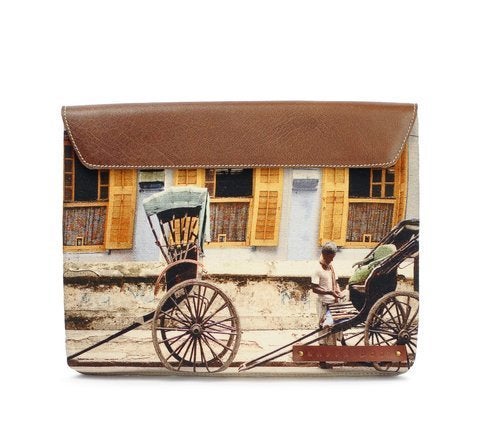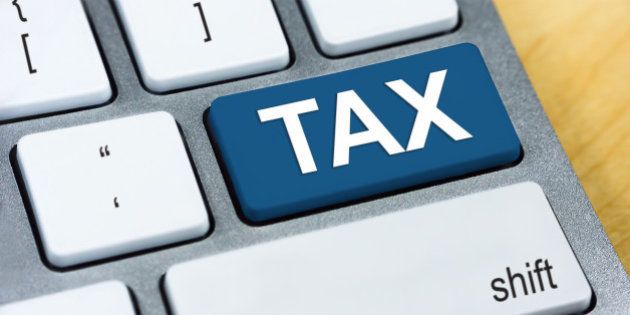
The Central Board of Direct Taxes (CBDT) recently released aggregated data for the direct tax collections in India for the first time. The stated purpose of publishing the data is to encourage "wider use and analysis of income tax data by departmental personnel and academicians." Here's what our analysis revealed.
What are direct taxes?
Direct taxes are taxes that are paid directly to the government. It includes tax on incomes of all form, including salaries, rental income, capital gains and professional or business income.
Who has PAN cards?
The number of PAN card holders has increased from 4 crore 36 lakh in Assessment Year(AY) 2011-12 to 5 crore 20 lakh in AY2013-14. This is an increase of 19.37% in two years.

Individuals account for 94.13% of all PAN Card holders. Firms and companies account for 3.34% of PAN cards issued.
Dreadful data
According to the 2011 Census, the population of India is 121 crore. This means that only 4.3% of India's population has PAN cards or pays any kind of direct tax. The actual number of people who filed a tax return in AY 2012-13 stood at less than 3 crore 12 lakh.
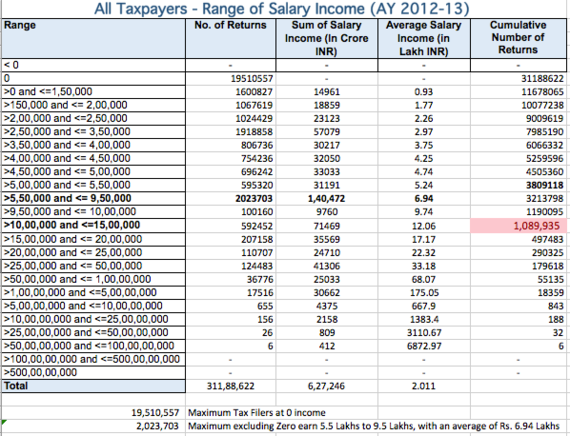
The truly dreadful part is that according to this data, out of this country's 121 crore population, only 11 lakh people earn a salary of more than ₹10 lakh per annum. That means that less than 0.091% of all the people in the country have a salary income of more than ₹10 lakh.
Out of this country's 121 crore population, only 11 lakh people earn a salary of more than ₹10 lakh per annum.
Only 38 lakh people in India earn a salary of more than ₹5.5 lakh per annum, which is less than 0.32% of the country's population.
The data is even worse for business income, which shows that only about 5 lakh people make a business income of more than ₹10 lakh per annum. This is 0.04% of the country's population.

Occupy Wall Street was a protest movement that started in the USA as a result of the 2008 financial crisis. People took to the streets to protest income inequality and raised slogan like "We are the 99%". The protestors claimed that the richest 1% in the US had taken over a disproportionate share of the country's resources and wealth, leaving nothing for the other 99%. This clearly is not the case in India.
In India, since you are reading this article there is a high likelihood that you are already in the top 1%. If you filed a tax return with individual or business income of more than ₹10 lakh, then you are in the top 0.2% of the highest earning individuals in India.
Either India is much poorer than I had imagined, or most people just don't file taxes.
This is dreadful. Either India is much poorer than I had imagined, or most people just don't file taxes. Agricultural income is exempt from income tax, which might lead to most people with only agricultural incomes not filing taxes. Testing if most people just aren't filing taxes or if most of our fellow citizens earn much less than I would have assumed, given India's glorious IT revolution and its status as a global power, is the subject for another project.
The dreadful continues
The state of Maharashtra alone accounted for over 40% of India's direct tax collection, while Delhi accounted for another 13.35%, taking the total to over 53%. Seven states out of the 29 accounted for over 80% of the direct tax collections in India. Ten states accounted for more than 90%.
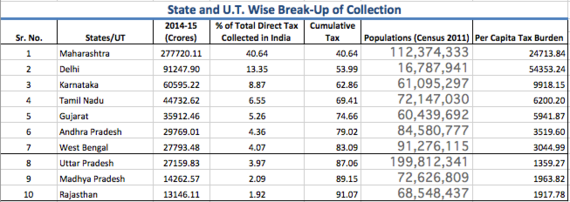
The worst tax collected to population ratio was seen in the northeastern states, but Jharkhand, Bihar, Chhattisgarh and Jammu & Kashmir also appeared on the list for the least per capita contribution to direct taxes.
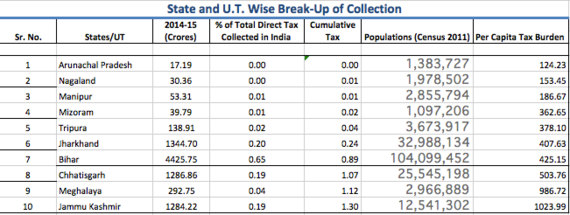
The following were the states with the highest per capita tax payment:
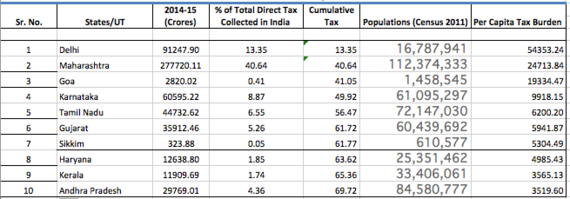
The silver linings
The proportion of direct taxes to total tax revenue has risen from 36.31% in 2000-01 to over 56% in 2014-15, and it continues to trend upwards. Direct tax to GDP ratio has also increased from 3.25% to 5.55%.
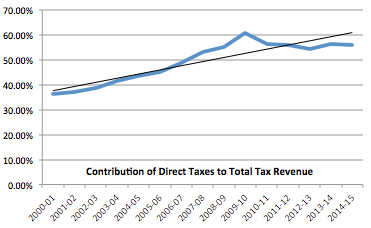
Both GDP and tax revenue have grown at a good rate in the past 15 years. The growth in tax revenue touched a high of over 35% in 2006-07 and 2007-08, while it remained close to 25% from 2003 to 2006.
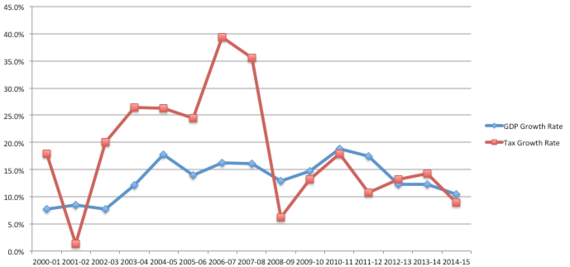
The cost of tax collection has also gone down from 1.36% to 0.59%.
These factors together show that the government is getting better at collecting direct taxes and compliance is increasing.
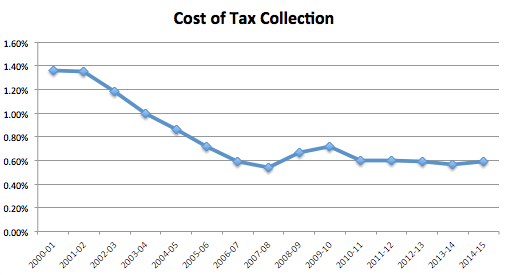
Conclusion
The data for direct taxes is very dismal. India continues to have very few tax assessees, and even amongst the people who file taxes, the stated incomes remain abysmally low. It is also disheartening to see that direct tax collections for India show that only a few states contribute to the country's tax base.
It is disheartening to see that direct tax collections for India show that only a few states contribute to the country's tax base.
There is some improvement in direct tax collections in the past 15 years and government revenue from direct taxes is rising, which could represent a positive trend for the nation.
There needs to be a comparison of consumption data with the income tax data to verify that only 16 lakh people (Salary + Business) in the country earn over ₹10 lakh per annum, as this statistic seems unbelievable in a country of 121 crore people.
Twitter: @INshivams
Originally written for the Chakravyuha Blog on Medium



Contact HuffPost India
Also see on HuffPost:
